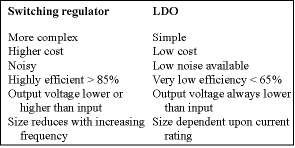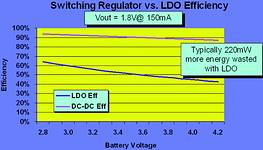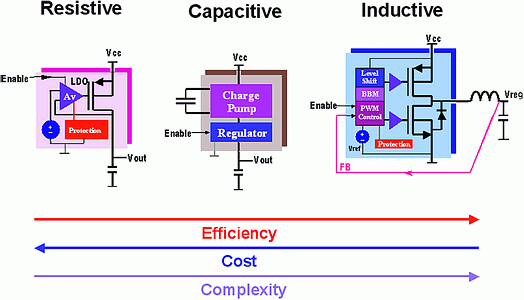
While PDAs, mobile phones and other portable appliances are small and compact, they utilise several voltage levels in a single system. Unfortunately, the majority of appliances only contain one battery, therefore one voltage, and the system designer must 'create' additional regulated voltages to meet the requirements of the system.
The battery of choice for portable applications is the lithium ion or polymer battery. A single cell lithium ion battery has a fully charged cell voltage of 4,2 V. Fully discharged, the cell voltage can be below 3 V. Many appliances feature both digital and analog ICs which all operate at different voltage levels. These voltages can be higher or lower than the battery voltage and must remain stable while the battery energy is consumed. This presents the designer with a complex problem; how to manage the energy from the battery to maximise the battery life between charges, while at the same time, offer the best combination of size, cost, complexity, and efficiency for each circuit or application. The solution is never an easy one and often compromises have to be made. The two main components for providing voltage conversion and regulation are linear and switching regulators and all portable power management systems comprise either one or a combination of both products. Let us examine each solution.
The simplest form of voltage converter is a linear regulator; it is cheap, small, easy to use, but can only produce a regulated output voltage, which is lower than the input voltage. Conversion takes place using a variable resistive element, which dissipates the unwanted voltage in the form of heat. Efficiency is a function of the differential between the input voltage and the output voltage plus the regulator's quiescent current. If the voltage differential is high then the efficiency is low and vice-versa. To ensure that the linear regulator is able to maintain a constant output voltage, there is a minimum input/output voltage, which must be maintained. This is called the 'drop-out' voltage. The lower this figure, the better, as it will ensure the maximum energy can be drained from the battery before the regulator falls out of regulation. Devices optimised for this feature are called low drop-out linear regulators or LDOs for short. These products can typically regulate a battery's output voltage to within a few hundred millivolts of the output voltage. However, as the dropout voltage has a major impact on the cost of the device, one must carefully consider the benefits of appliance operating time verses cost and a solution may not necessary utilise the lowest dropout voltage LDO. LDOs are best suited for low current applications, where the input to output differential is low, eg, producing 3,0 V from a single lithium ion battery (3,0-4,2 V). The efficiency equation is shown below:
Typically, when operating under optimum conditions, the highest operating efficiency of an LDO can be 65% or, more significantly, 35% of the energy is wasted.
For systems where the load current varies significantly the IGND or quiescent current of the LDO becomes a major factor in the efficiency equation. Devices optimised for this application include the AAT3221, which features a miserly 1,1 µA of IGND. As you can see from Table 1, compared to conventional LDOs, the AnalogicTech's product can increase the efficiency of the system by as much as 20%. Another important parameter to consider when powering noise sensitive circuits in mobile phones, for example, is the noise generated by the regulator. The LDO provides a very good solution for this application as a linear circuit generates only small amounts of noise in the order of 30-45 µV. The size of the LDO is a function of the input to output voltage differential and load current. For the majority of portable applications the SOT23-5 an industry standard package is commonly used, but it is closely being followed by the SC70JW, which provides the same electrical performance while occupying only 55% of the board space. Other parameters for consideration are transient response, power supply rejection and also shutdown current.

From a pure efficiency point of view, where cost and size are not so critical, eg, high-end mobile phones and PDAs, switching regulators can be used to significantly increase the battery life. Unlike the LDO, switching regulators can achieve efficiencies of up to 95% and can produce output voltages both above and below the battery voltage. A comparison is shown in Figure 1. In this practical example over 50% of the battery energy is wasted during the conversion from the battery voltage to the IC's operating voltage.

As digital IC technology's feature size decreases, and its operating voltage follows the situation will gradually deteriorate and the differential between the battery voltage and the IC voltage will become very high. Some DSP cores operate at voltages below 1 V and even mobile phone base-band ICs are now available significantly below 3 V. In this case the only real solution is a switching regulator called a synchronous Buck converter. The synchronous Buck converter uses two integrated semiconductor switches to switch the battery voltage at a high frequency with a varying duty cycle to regulate the voltage. The result is then passed through a filter consisting of an inductor and a capacitor, which restores the DC content. While the conversion efficiency is very high, the Buck converter does increase the cost of the system, consumes more board space and at the same time introduces unwanted switching noise. However, by switching at a very high frequency (>1 MHz) the size of the inductor and capacitor can be significantly reduced and unwanted noise can be filtered out by the addition of a low noise LDO!
In between the LDO and the inductive switching regulator (Figure 2) is the simplest form of switching regulator called a charge pump or voltage doubler. This is often used where a voltage higher than the battery voltage is required. An example of this is to power white LEDs used as the backlight to illuminate a colour display. The AAT3110 is such a device and operates from a 2,7 to 5 V input. With the addition of three small capacitors, it can produce a regulated 5 V supply at up to 150 mA. Due the optimisation of the integrated switches and its extremely low quiescent current, efficiencies of over 90% can be achieved. It is a simple, small and cost effective solution.

In conclusion, many power management solutions will feature a combination of all three types of regulators to provide a solution that is a good compromise between prolonged battery life and cost. As the differential between battery voltage and IC operating voltages widens, most power management schemes will follow a distributed power type architecture, where a switching regulator will provide an interim voltage and a number of LDOs will perform the final conversion and regulated stage. Here the high efficiency of the switching regulator can be shared to optimise the efficiency of the LDOs.
For more information contact Stephen Delport, Hi-Q Electronics - South Africa, 021 595 1307, [email protected]
| Tel: | +27 21 595 1307 |
| Email: | [email protected] |
| www: | www.hi-q.co.za |
| Articles: | More information and articles about Hi-Q Electronics |

© Technews Publishing (Pty) Ltd | All Rights Reserved